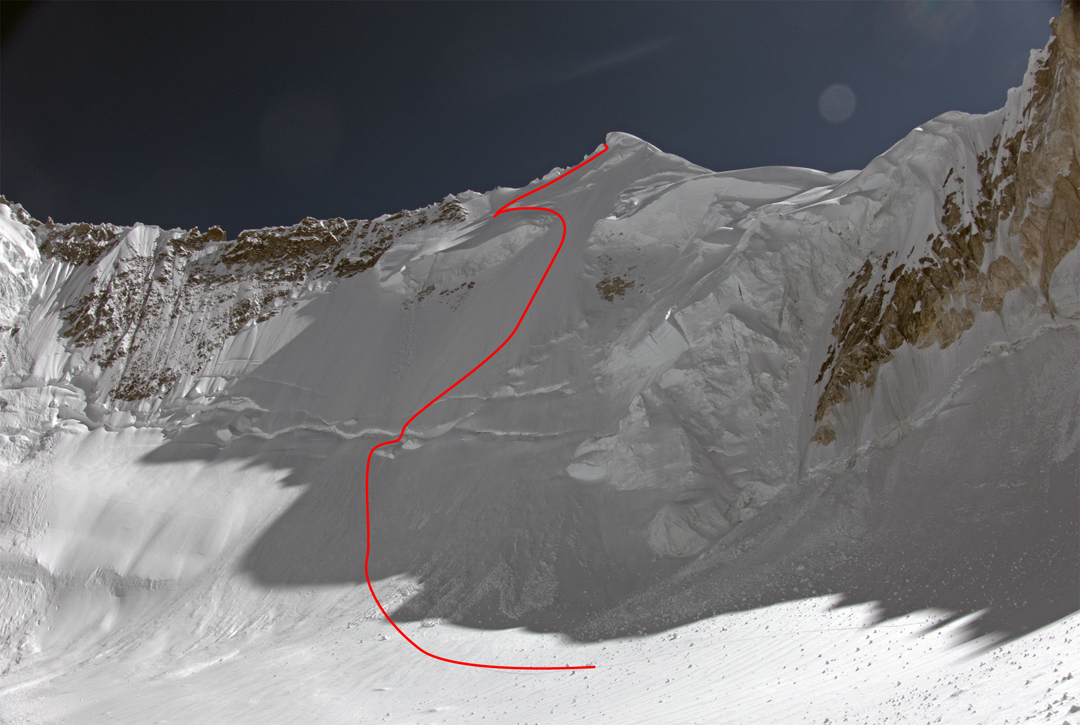Gasherbrum VII, First Ascent via Northeast Face and Ski Descent
Pakistan, Baltoro Muztagh

After my partial ski descent of Nanga Parbat in early July (see story here), I traveled to Skardu to meet Francesco Cassardo. Our plan was to make the first ascent of Gasherbrum VII (6,955m) via the northeast face and then ski down. [Gasherbrum VII, formerly Gasherbrum V Northwest 2 or Corno d'Angolo, was the only unclimbed Gasherbrum. It sits on the ridge between Gasherbrums IV and V, at the head of the southwestern branch of the Gasherbrum Glacier.]
We arrived at the standard Gasherbrum base camp (5,050m) on July 16, and on the 19th left to establish Camp 1 at 6,100m below the face. Francesco said he felt good, and we agreed to try for the summit the next day. I felt strong and thought it was possible to reach the top in one day. We set off on the 20th, a beautiful day with little wind. We used skins to the first bergschrund, then carried our skis as we continued up. The slope was good névé [reported to be nearly 60°], and we climbed unroped. This part of the ski descent would be really exciting. I had been faster than Francesco from the start, but we kept in sight.
After around 500m, I was level with the top of a large serac barrier to the left, and decided to traverse over the top of it to reach a couloir through the second bergschrund on the left side of the face. However, before reaching the couloir I decided to climb straight up a steep snow wall, but it wasn't the good snow I expected; there was only 1cm over blue ice. I climbed around 20m of 70°, after which the angle eased and I was on skiable snow again. I shouted to Francesco to take the snow couloir to the left, which would be safer. It was now easy but tiring till just below the top, where a 50m tight, icy couloir led to the summit.

After 40 minutes on top, I started the descent on skis. The tight couloir was really scary, but once through it the angle eased to about 50° or so, and the face opened up. I headed for the snow couloir through the second bergschrund, jumped it, and met Francesco. I had a talk with him about the upper part and suggested that if he was not 100 percent sure he shouldn’t try to ski, but instead downclimb with crampons. I continued my descent, skiing the relaxing traverse above the big serac and then turning right onto the 60° slope. Fortunately, it is wide and the snow was good. I was skiing better than ever in my life and was able to enjoy it, though there was no margin for error.
Back on the glacier, I turned to watch Francesco, who had given up trying to pass the bergschrund and was starting to ski down. When he made the first turn onto the 60° slope, he fell, lost his skis, and began to slide. Francesco fell 500m, losing his rucksack and many of his clothes. He came to a halt at 6,300m. I expected the worst when I reached his motionless body, but amazingly he had survived. He was conscious but in a bad way. I used my satellite phone to call for an immediate rescue and then dug a snow cave, went back to Camp 1, and brought up sleeping bags.
The next morning, rescue helicopters were being employed in a separate mission around Broad Peak, and by the time they were free, the weather had become too warm and unstable to reach us. Fortunately, in Gasherbrum base camp at the time were Don Bowie, Denis Urubko, and two Polish climbers, Janusz Adamski and Jaroslaw Zdanowich. They decided to take the matter into their own hands. By nightfall they had reached us. Deciding it would be better if we could get Francesco to a lower spot, easier for helicopter evacuation, we built a rudimentary stretcher and dragged him to 6,100m. At this point we took a gamble and continued through the night, reaching Gasherbrum II’s Camp 1 at around 5,900m. The following morning a helicopter took Francesco to Skardu Military Hospital. His only fractures were to a wrist, clavicle, and one vertebra, and he damaged ligaments in one knee. Although he had treatable frostbite on his nose and ears, it was more severe on the hands, and he eventually lost the first phalanx from all fingers and thumbs.
– Cala Cimenti, Italy




